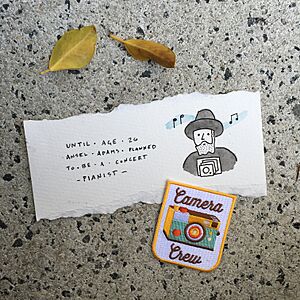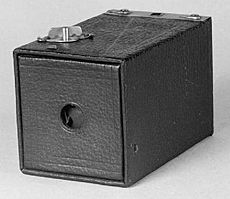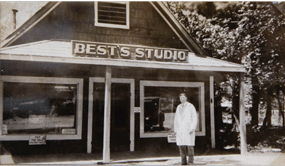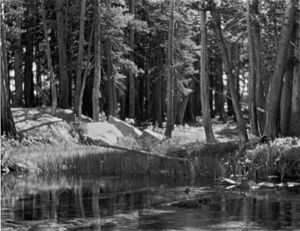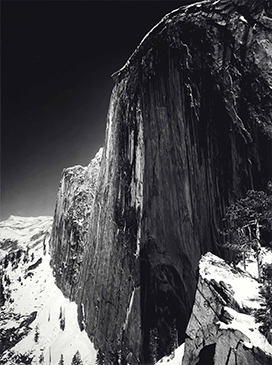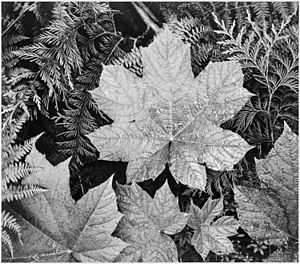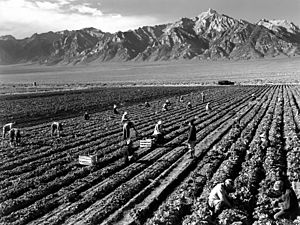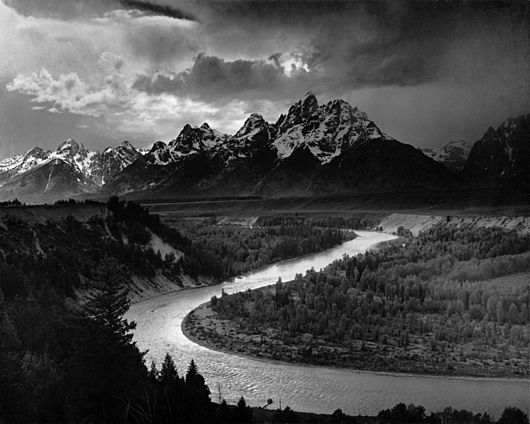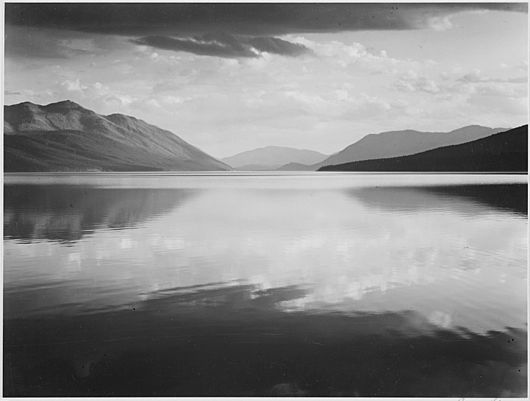Ansel Adams facts for kids
Quick facts for kids
Ansel Adams
|
|
|---|---|
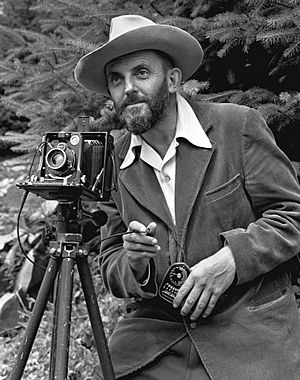
Adams c. 1950
|
|
| Born |
Ansel Easton Adams
February 20, 1902 |
| Died | April 22, 1984 (aged 82) Monterey, California, U.S.
|
| Resting place | Adams's ashes were placed on the summit of Mount Ansel Adams in California's Ansel Adams Wilderness area. |
| Known for | Photography and conservationism |
| Movement | Group f/64 |
| Spouse(s) |
Virginia Rose Best
(m. 1928) |
| Awards | Presidential Medal of Freedom 1980 |
| Elected | Board of Directors, Sierra Club |
| Patron(s) | Albert M. Bender |
| Memorial(s) | Ansel Adams Wilderness, Mount Ansel Adams |
Ansel Easton Adams (February 20, 1902 – April 22, 1984) was a famous American landscape photographer. He was also a strong environmentalist. He is best known for his amazing black-and-white pictures of the American West.
Ansel Adams helped start Group f/64. This was a group of photographers who believed in "pure" photography. They wanted sharp, clear images that showed all the details and tones of a scene. He also worked with Fred Archer to create the Zone System. This system helped photographers control how light and dark their photos would be. It allowed them to create images with incredible clarity and depth.
Adams loved nature and worked hard to protect it. When he was 12, he got his first camera during a trip to Yosemite National Park. He later joined the Sierra Club, a group that works to save wild places. He even took photos for the United States Department of the Interior to show the beauty of national parks. For his efforts, he received the Presidential Medal of Freedom in 1980. This is a very high award in the U.S.
Ansel Adams also helped photography become recognized as a serious art form. He advised on setting up the photography department at the Museum of Modern Art in New York. He also helped start the photography magazine Aperture and the Center for Creative Photography at the University of Arizona.
Ansel Adams's Early Life
Ansel Adams was born in San Francisco, California. He was the only child of Charles Hitchcock Adams and Olive Bray. His father's family came from New England. His grandfather had a successful lumber business. Later in life, Ansel Adams was sad about how many great redwood forests were cut down by this industry.
Childhood and Education
One of Adams's first memories was seeing smoke from the fires after the 1906 San Francisco earthquake. He was four years old. An aftershock later caused him to fall, breaking his nose. It remained crooked for the rest of his life.
His family moved to a new home near the Seacliff neighborhood. It had a great view of the Golden Gate. Ansel was a very active child. He loved nature from a young age. He enjoyed collecting bugs and exploring Lobos Creek and the sea cliffs.
Ansel and his father shared a love for astronomy. They often visited the Lick Observatory. His father later worked for the Astronomical Society of the Pacific.
Ansel had trouble in school. He was restless and didn't pay attention. So, when he was 12, his father took him out of school. For two years, he was taught by tutors, his aunt, and his father. His father taught him to live a simple, moral life and care for nature. Ansel later finished his formal schooling in 1917. He had a close relationship with his father, but his mother did not like his interest in photography.
Youth and Discovering Photography
Ansel Adams started playing the piano at age 12. He taught himself and dreamed of becoming a classical pianist. Music teachers helped him improve his skills.
His life changed in 1916 when he first visited Yosemite National Park with his family. He later wrote that Yosemite was "glorious" and that "A new era began for me." His father gave him his first camera, an Eastman Kodak Brownie box camera. He immediately started taking pictures. The next year, he returned to Yosemite with better cameras. He also learned how to develop photos in a darkroom.
Ansel read photography magazines and joined camera clubs. He explored the High Sierra mountains with a friend, Francis Holman. Holman taught him about camping and climbing.
While in Yosemite, Ansel needed a piano to practice. He met Harry Best, a landscape painter who had a studio there. Best let Ansel practice on his piano. Ansel became interested in Best's daughter, Virginia. They later married. Today, Best's studio is known as the Ansel Adams Gallery and is still owned by the Adams family.
Joining the Sierra Club
At 17, Ansel Adams joined the Sierra Club. This group works to protect wild places. He worked as a caretaker at the Sierra Club's lodge in Yosemite. He stayed a member his whole life and served on its board of directors for 37 years. He also took photos for the club's annual trips into the mountains.
Ansel's best friend was Cedric Wright, a violinist and photographer. They shared a philosophy about finding beauty in life and art. Ansel later said, "I believe in beauty. I believe in stones and water, air and soil, people and their future and their fate."
For many years, Ansel worked hard on his piano playing. He gave lessons to earn money for a grand piano. He was a talented pianist, but he eventually decided that he would be better as a photographer.
Ansel Adams's Photography Career
Early Photos and New Style
Ansel Adams's first photos were published in 1921. His early pictures showed careful planning and good use of light and shadow.
In the 1920s, many photographers used a style called pictorialism. This made photos look like paintings, with soft focus and diffused light. Adams tried some of these techniques at first. But by 1925, he decided to use a more realistic style. He wanted sharp focus, strong contrast, and precise darkroom work.
Monolith and Visualization
In 1927, Adams worked with Albert M. Bender, an art supporter. Bender helped Adams create his first collection of photos in his new style. It included his famous picture, Monolith, the Face of Half Dome. He took this photo with a special camera and a red filter to make the sky look very dark.
Adams later said that he "visualized" the final image in his mind before taking the picture. This idea of visualization became a key part of his photography. Monolith was a very important photo because it showed how much he could change the light and dark parts of an image.
His first photo collection was a big success. He also learned a lot about printing techniques, which helped him make his photos look their best. In 1928, Ansel married Virginia Best.
Pure Photography and Group f/64
The 1930s were a very creative time for Adams. He explored new subjects, from close-ups of leaves to large factories.
He met photographer Paul Strand, who greatly influenced him. Strand's photos were simple and detailed, very different from the soft-focus style popular then. Strand encouraged Adams to focus fully on photography.
In 1931, Adams had his first solo museum show at the Smithsonian Institution. Critics loved his photos, saying they were "like portraits of the giant peaks."
In 1932, Adams, Imogen Cunningham, and Edward Weston formed Group f/64. This group believed in "pure photography." They wanted sharp, clear photos that showed reality. The name "f/64" comes from a very small camera opening (aperture) that creates a lot of depth in a photo. Their goal was to make photography its own art form, not just copy painting.
Adams opened his own gallery in San Francisco in 1933. He also started writing articles and his first instructional book, Making a Photograph, in 1935.
Protecting the Wilderness
Adams used his photographs to help protect nature. He was worried about too much development in Yosemite Valley. In 1938, he created a book called Sierra Nevada: The John Muir Trail. This book helped convince Congress to make Kings Canyon National Park a national park in 1940.
In 1935, Adams took one of his most famous photos, Clearing Winter Storm. It shows the entire Yosemite Valley after a snowstorm. He had a successful show of his work in New York in 1936. Sadly, a fire in his darkroom in Yosemite almost destroyed many of his negatives, including Clearing Winter Storm.
In 1937, Adams went on a camping trip in Arizona with artist Georgia O'Keeffe. He took a famous photo of her at Canyon de Chelly. He said some of his best photos were taken there.
Adams also took many commercial photos for companies like Kodak and Fortune magazine to earn money.
Ansel Adams in the 1940s
In 1940, Adams helped create A Pageant of Photography. This was the biggest photography show in the West at the time. He also wrote a children's book and a guide to Yosemite Valley. He started teaching photography workshops.
National Park Project
In 1941, Adams got a contract with the National Park Service. He was to photograph national parks and other areas. He went on a road trip with his friend Cedric and his son Michael. He took many famous pictures during this time.
Moonrise, Hernandez
While in New Mexico for the project, Adams took one of his most famous photos: Moonrise, Hernandez, New Mexico. It shows the Moon rising over a small village with snowy mountains. The light was fading fast, and he had to quickly figure out the right camera settings.
This photo was first published in a photography annual in 1943. It became very popular. Over 40 years, Adams made more than 1,300 prints of Moonrise. These prints helped him become financially independent. Some prints have sold for hundreds of thousands of dollars.
The project ended in 1942. Adams sent many small prints to the government. But he kept the negatives, including those for Moonrise. He knew the government might not take good care of them. It was later figured out that Moonrise was taken on November 1, 1941. Since he wasn't working for the government that day, the photo belonged to him.
World War II and Manzanar

Adams was upset by the Japanese American internment during World War II. He visited the Manzanar War Relocation Center in California. He took photos there that were later published in a book called Born Free and Equal: The Story of Loyal Japanese-Americans. This book was very different from his usual landscape work.
In 1943, Adams put a camera platform on the roof of his car. This helped him take pictures from a higher view. Many of his later landscapes were taken from his car, not from mountain tops.
Adams received three Guggenheim Fellowships during his career. The first was in 1946 to photograph every national park. He photographed 27 of the 28 parks, creating memorable images of places like Old Faithful Geyser and Grand Teton.
In 1945, Adams helped start the first fine art photography department at the California School of Fine Arts. He invited famous photographers like Dorothea Lange to teach there.
Later Career and Legacy
1950s and Beyond
In 1952, Adams helped start Aperture magazine. It was a serious journal for photography. He also contributed to Arizona Highways magazine.
From 1955 to 1981, Adams held annual photography workshops in Yosemite. Thousands of students attended them. He also worked as a consultant for Polaroid Corporation. He took many photos with Polaroid cameras. His favorite photo taken with a Hasselblad camera was Moon and Half Dome (1960).
In the 1960s, art galleries started showing Adams's photos alongside paintings. In 1963, he was asked to photograph the University of California campuses for their 100th anniversary. This collection, called Fiat Lux, is now at the Museum of Photography at the University of California, Riverside.
Adams moved to a new home in Carmel Highlands in 1965. He spent a lot of time printing his old negatives. In 1975, he helped create the Center for Creative Photography at the University of Arizona.
In 1979, President Jimmy Carter asked Adams to take his official portrait. This was the first time a U.S. president had an official photo taken by a photographer.
Death and Lasting Impact
Ansel Adams passed away on April 22, 1984, at age 82. His ashes were scattered on Half Dome in Yosemite National Park.
His photographs are still very popular. Many of his original prints have sold for very high prices at auctions. For example, a print of The Tetons and the Snake River sold for $988,000 in 2020.
Art critic John Szarkowski said that Americans loved Ansel Adams's work and him as a person. He called it an "extraordinary phenomenon."
Ansel Adams's Contributions
Capturing the American West
Ansel Adams's photos of the American West are unique. He captured the changing light and atmosphere of the landscape. He showed how nature looks different at various times of day and year.
His photos were not just records of places. They showed his deep connection to nature and his desire to protect it. His black-and-white images made nature seem like a spiritual place.
In 1955, one of his photos, Mount Williamson, was chosen for a huge exhibition called The Family of Man. It was the largest print in the show and was seen by millions of people.
Group f/64 and Pure Photography
In 1932, Adams helped form Group f/64. This group believed in "straight" or "pure" photography. They wanted sharp, clear images with lots of detail. They used a very small camera opening, f/64, to get great depth in their photos.
The group's statement said that pure photography should not try to copy other art forms like painting. It should develop its own unique style based on what cameras can do.
Adams later used these ideas to create the Zone System.
The Zone System
Around 1939–1940, Adams and Fred Archer developed the Zone System. This was a way to control the brightness and darkness in a photograph. It uses a scale from Zone 0 (pure black) to Zone X (pure white).
Photographers could measure the light in different parts of a scene. Then, they used the Zone System to decide how to expose the film and develop the negative. This helped them get exactly the look they wanted in the final print. The Zone System is still used today in both film and digital photography.
Photography at MoMA
In 1940, Adams helped create the photography department at the Museum of Modern Art (MoMA) in New York. This was a big step for photography. MoMA was the first major American art museum to have a photography department. This showed that photography was now seen as an art form, just like painting and sculpture.
The department's first exhibition showed high-quality artistic photographs. Adams was a key advisor in setting up this important department.
Environmental Protection Efforts
Ansel Adams was deeply concerned about nature. He saw how industrial growth was harming the land. He wrote about the "tragedy" of soil erosion and shrinking forests. He believed that losing wilderness also "shrivels the spirit of the people."
He worked tirelessly to protect wild places. His photographs helped people see the beauty of nature and understand why it needed to be saved.
Awards and Honors
Ansel Adams received many awards during his life and after his death.
- In 1976, he received an Honorary Fellowship of the Royal Photographic Society.
- In 1981, he won the Hasselblad Award.
- Two of his photos, The Tetons and the Snake River and a view of the Golden Gate Bridge, were sent into space on the Voyager Golden Record. These images were meant to show alien civilizations what Earth is like.
For his work in conservation:
- He received the Sierra Club John Muir Award in 1963.
- In 1968, he got the Conservation Service Award, the highest award from the Department of the Interior.
- In 1980, President Jimmy Carter gave him the Presidential Medal of Freedom. This is the highest civilian honor in the U.S. It was for his efforts to protect America's wild areas, both through his photos and his actions.
Adams also received honorary degrees from Harvard and Yale universities. In 2007, he was inducted into the California Hall of Fame.
Several things are named after him:
- The Ansel Adams Award for Conservation Photography was created in 1971 by the Sierra Club.
- The Ansel Adams Award for Conservation was started in 1980 by The Wilderness Society.
- A wilderness area and a mountain peak in California were renamed the Ansel Adams Wilderness and Mount Ansel Adams in 1985.
In 1984, Adams was inducted into the International Photography Hall of Fame.
Ansel Adams's Photographs
Color Images
Ansel Adams is famous for his black-and-white photos. But he also took many color pictures. However, he preferred black-and-white photography. He felt it allowed him more control to create strong, expressive images. He didn't think his color work was as important.
Famous Photographs
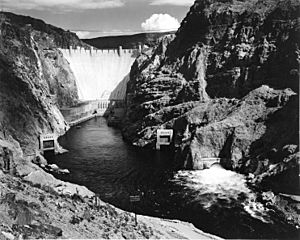
Here are some of Ansel Adams's most well-known photographs:
- Lodgepole Pines, Lyell Fork of the Merced River, Yosemite National Park, 1921
- Monolith, the Face of Half Dome, Yosemite National Park, 1927
- Rose and Driftwood, San Francisco, California, 1932
- Georgia O'Keeffe and Orville Cox, Canyon de Chelly National Monument, 1937
- Clearing Winter Storm, Yosemite National Park, c. 1937
- Moonrise, Hernandez, New Mexico, 1941
- Evening, McDonald Lake, Glacier National Park, 1942
- The Tetons and the Snake River, Grand Teton National Park, 1942
- Winter Sunrise, Sierra Nevada, from Lone Pine, California, 1944
- Mount Williamson, Sierra Nevada, from Manzanar, California, 1944
- Aspens, Northern New Mexico, 1958
- Moon and Half Dome, Yosemite National Park, California, 1960
- El Capitan, Winter Sunrise, 1968
Published Works
Ansel Adams also wrote many books about photography:
- Adams, Ansel (1948). Basic photo. New York: Morgan and Lester.
- Adams, Ansel (1948). The negative: exposure and development. New York; London: Morgan and Lester; The Fountain Press.
- Adams, Ansel (1950). The print: contact printing and enlarging. Boston: New York Graphic Society. ISBN 978-0-8212-0718-5.
- Adams, Ansel (1970). Camera and lens: the creative approach : studio, laboratory, and operation. ISBN 978-0-87100-056-9.
- Adams, Ansel (1974). Images 1923-1974. Boston: New York Graphic Society. ISBN 978-0-8212-0600-3.
- Adams, Ansel (1977). Natural Light Photography. Boston: Little, Brown & Co., for New York Graphic Society. ISBN 978-0-8212-0719-2.
- Adams, Ansel; Baker, Robert (1978). Polaroid Land photography. Boston: New York Graphic Society. ISBN 978-0-8212-0729-1.
- Adams, Ansel (1979). Yosemite and the Range of Light. Boston: New York Graphic Society. ISBN 978-0-8212-0750-5.
Camera Equipment
Ansel Adams used many different types of cameras. Most of his famous images were taken with large 8x10 and 4x5 view cameras. These cameras use big film sheets and give very detailed images. He also used smaller cameras, like 35mm and medium format roll film cameras.
In a 1958 documentary, Adams showed some of his camera gear:
- An 8x10 view camera with 20 film holders and 4 lenses.
- A special 7x17 panorama camera with a lens and 5 film holders.
- A 4x5 view camera with 6 different lenses.
Adams even had a platform mounted on the roof of his car. This allowed him to take photos from a higher viewpoint, which helped him capture his wide, sweeping landscapes.
See Also
 In Spanish: Ansel Adams para niños
In Spanish: Ansel Adams para niños
- Environmental protection
- Monochrome photography


